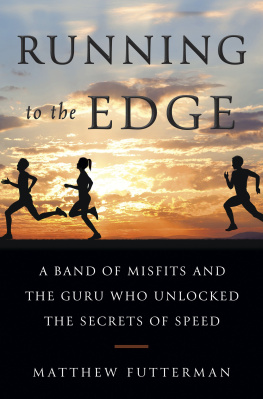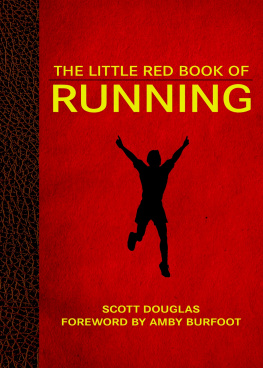RUNNING TO GLORY
RUNNING TO GLORY
An Unlikely Team, A Challenging Season, and Chasing the American Dream
Sam McManis

An imprint of The Rowman & Littlefield Publishing Group, Inc.
4501 Forbes Blvd., Ste. 200
Lanham, MD 20706
www.rowman.com
Distributed by NATIONAL BOOK NETWORK
Copyright 2019 Sam McManis
All rights reserved. No part of this book may be reproduced in any form or by any electronic or mechanical means, including information storage and retrieval systems, without written permission from the publisher, except by a reviewer who may quote passages in a review.
British Library Cataloguing in Publication Information available
Library of Congress Cataloging-in-Publication Data available
ISBN 978-1-4930-4152-7 (hardcover)
ISBN 978-1-4930-4153-4 (e-book)
 The paper used in this publication meets the minimum requirements of American National Standard for Information SciencesPermanence of Paper for Printed Library Materials, ANSI/NISO Z39.48-1992.
The paper used in this publication meets the minimum requirements of American National Standard for Information SciencesPermanence of Paper for Printed Library Materials, ANSI/NISO Z39.48-1992.
Printed in the United States of America
Contents
Starting Line
T he sight, so unexpected and so compelling, that ultimately led me to become immersed in the all-consuming world of high-school cross-country happened in late afternoon, early October 2016, in my new place of residence, the blue-collar-poor but agriculture-rich city of Yakima, Washington. I was driving up 40th Avenue in one of the busiest strip-mall centers in a low-rise city replete with them. I had been distracted by the radio, the seemingly nonstop coverage on National Public Radios (NPR) of the heated presidential race, and I failed to see that traffic had backed up to a standstilla rarity in this towntraffic had backed up to a standstill. I stopped just in time and, once my heart rate returned to normal, stared ahead with simmering dread at the line of cars snaking up the hill, a passel of Subaru all-wheel drives, pickup trucks with dauntingly high ground clearance, and a few early-model, low-slung sedans that had seen better days but throbbed with heavy bass beats from blown-out speakers.
There emerged from the side of road, along a cracked and sorry excuse for a sidewalk, a hive of bobbing heads loping at a steady, almost metronomic pacearms swinging and legs churning with impressive precision. Two hives, actually. First came a group of boys, about 10 strong and primarily Hispanic, nearly all shirtless and stick thin, their mahogany torsos gleaming slickly in the sun as they dutifully ground out a brisk pace. From farther up the road came a clump of girls, this pack a little more diffuse, their ponytails swishing, their stride more of a prance than a pounding, their collective mien jovial and chatty, save a short girl in front whose brown hair was gathered in a severe bun and whose full attention seemed focused on the task at hand.
The traffic light turned green just then, but I didnt make it through the intersection. This allowed me more time to watch these young runners at work. I figured it was the cross-country team from Eisenhower High School, located about two miles south of where I sat idling on 40th Avenue. The school is 70 percent Hispanic, with its share of DACA (Delayed Action for Childhood Arrivals) kids, and so low-income it qualifies for free breakfast and lunch for all students. And now it seemed clear Eisenhower also had some very swift runners. By the time they reached the bottom of the hill, near the intersection where I awaited release from the traffic snarl, they made a slight left turn and pooled at the base of a cul-de-sac along a road heading straight up, up, up a half mile to Yakimas only true exclusive neighborhood on the aptly named Scenic Drive. They milled about for maybe 10 seconds and then took off like an elk herd. At that point, though, so did I. The light had changed, and traffic flowed once more. But in that instant, I swiveled my head to the right and saw these runners, silhouetted by the sun, lower their heads as if in supplication and proceed in a long, snaking line up the steep incline. Unbidden, a half-remembered line from the poet Theodore Roethke came to me: May they be taken by the true burning / May they flame into being!
This is youth, I thought. This is sport.
This, too, is decidedly not football, arguably our new national pastime, our overriding obsession, all of that rah-rah Friday Night Lights high-school hoopla celebrated across the land each autumn. These, rather, were just kids out on a run, training for competitions that usually take place in the dew-saturated dawn of Saturday morning, long after the lights of Friday night, with the concomitant revelry and pageantry that high-school football engenders, have been extinguished. Cross-country, I thought in that moment, has to be the purest form of sport to be found. Run. Just go run. The fastest, the most fit, wins. Period. And the races, fittingly, traverse varying terrainnot the sheer monotony of circling a track. Like life, if you are of a metaphoric bent. Unpredictable. Uphill. Slightly dangerous. Often exhilarating. In cross-country, you never know what obstacles are around the bend, but you do know that you will have to deal with whatever comes, to push through, regardless of the pain involved. Cross-country runners love and hate the pain, perhaps in equal measure. The love part must dominate, because, if not, why else would they do it? Not for adulation. A cross-country runner is not going to be Homecoming King, not going to be the queen-bee popular girl, not going to have cheerleaders shaking pom-poms celebrating her or his sporting exploits. To run is to move through life with purpose, to keep putting one foot in front of the other until a clear destination emerges.
And for a school such as Eisenhower, many of whose students are children of farm workers and struggle to get by financially, the elemental nature of cross-country perhaps can serve as a socioeconomic and athletic leveler with those more affluent, predominantly white-dominated teams from schools in Seattle or Spokane or, heck, even just 70 miles away in the Tri-Cities of Pasco, Kennewick, and Richland. Whats more, in a city saturated with fast-food joints and where bike lanes and sidewalks are merely rumors, these runners seemed to represent a rebuke, maybe even an answer, to the alarming rate of childhood obesity (37 percent) and type 2 diabetes (30 percent) endemic in the entire Yakima Valley.
All this I thought as I turned down the yakking pundits on NPR and just contemplated that brief, sublime sight of runners in the bloom of youth. Where, I wondered, is the literary paean to cross-country that, according to the National Federation of State High Schools Associations, attracts more than a million participants each fall ? Who has written this sports Friday Night Lights , that seminal 1990 book of sporting literature that later became a movie and TV show? Sure, in early 2015, Disney had released a movie, McFarland, USA , about a plucky band of 1980s Hispanic farm kids in California who, overcoming the requisite Disneyfied adversity, won a small school cross-country title. But that movie, based on a true story, frankly was mostly the stuff of Hollywood, full of embellishment and brimming with poetic license and cheap sentiment. Where, I wondered, could one find the real version, the expanded and nuanced look at a minority high-school team that embraces this so-called minor sport and produces winning teams and quality students, year in and year out, for decades on end?
* * *
Turned out it could be found right there in the town I just recently had begun to call home. What I was doing in Yakima, after a lifetime in California11 years in the Sacramento area and, before that, another decade or so in the Bay Area and in Los Angeles during my formative yearswas to reinvent myself after three decades as a staff writer for daily newspapers, a media platform that, if not dying, was at the very least being moved into assisted living by its younger, hipper high-tech descendants. I had a vague, inchoate plangrad school, English literature, and then what?and my wife, a nurse practitioner, wanted to be closer to our daughter off at college in the western part of Washington State.
Next page












 The paper used in this publication meets the minimum requirements of American National Standard for Information SciencesPermanence of Paper for Printed Library Materials, ANSI/NISO Z39.48-1992.
The paper used in this publication meets the minimum requirements of American National Standard for Information SciencesPermanence of Paper for Printed Library Materials, ANSI/NISO Z39.48-1992.